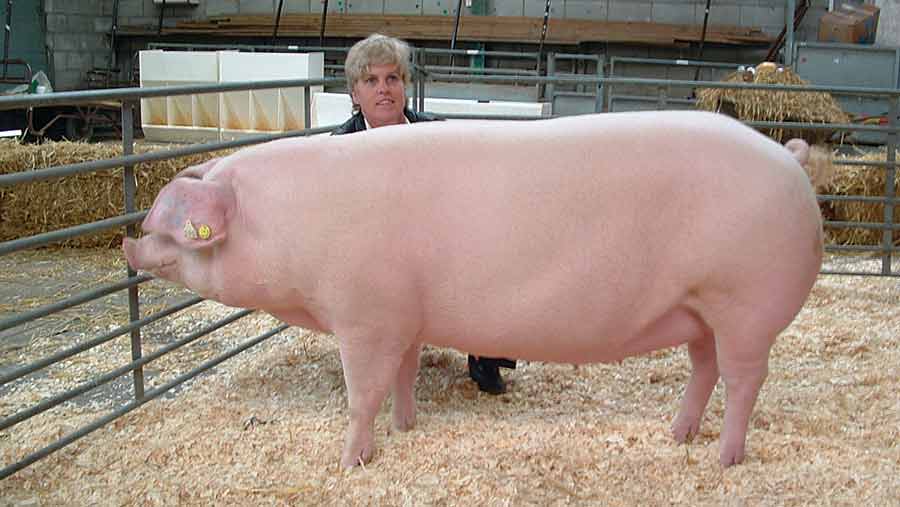Artificial Insemination venture revives once endangered Welsh Pig

Two breeders are helping to increase global numbers of the Welsh Pig by working with an artificial insemination company.
Ken Austin and his partner, Sian Hopkins, run the Burry Herd of over 200 Welsh Pig breeding sows; the herd incorporates 25 female lines and 11 male lines.
Welsh Pig numbers diminished when hybrids became more popular, but interest in the breed is increasing as pig producers recognise its value in producing sows with high milk production and good mothering abilities.
To help other breeders build up numbers, a boar from the Burry Herd, Burry Imperial 6466, has been sold to the Deer Park AI Centre in Northern Ireland in an initiative run in association with the Rare Breeds Survival Trust and the British Pig Association.
See also: Feeding pigs silage offers sustainability gains
The boar is from a family that has not previously been used for artificial insemination. This will allow breeders, particularly small herds, to access good genetics, says Mr Austin.
“If there are three or four different lines, the small herd can select the boar that is most appropriate to the sow rather than just using a boar because that is the one that is available locally,” adds Mr Austin who says eventually they would like to see all 11 male lines available to breeders.
Not only is there interest from breeders in the UK but from overseas too.
If a sow has a weak point we use a boar that is strong on that point. Breeding genetics is like a jigsaw puzzle, it’s finding the right males to match the right females Ken Austin, Welsh Pig breeder
Nigel Overend, of the Deer Park AI Centre, says Welsh Pig semen has already been exported to Asia and America.
“The Welsh Pig is proving popular as a dam line boar, it is very suitable for breeding good females. The modern day sow is producing large litters so it is important to have a female that is able to produce good volumes of milk,’’ he says.
“Some of the old breeds like the Welsh Pig have genes that are lacking in the modern animal because they have been bred out. No matter what breed you are working with you have to go back to the foundations.’’
Management at Burry Dairy Farm
Mr Austin first kept Welsh Pigs at Burry Dairy Farm, Reynoldston, in the 1970s when, along with the Large White, it was the most popular breed.
He was forced to sell his herd after illness prevented him from looking after the pigs but more than 20 years later, with the Welsh Pig on the list of endangered species, he decided to build up a herd once more.

Mr Austin and Ms Hopkins now have more than 1,000 pigs, including a herd of Large Whites.
The gilts are mated at nine months, to farrow no later than 13 months. The Welsh Pigs average 11.5 pigs born and 10.5 pigs weaned.
“We don’t use farrowing crates, infrared lamps or any form of heating, just simple straw-bedded pens, winter or summer,’’ says Mr Austin.
See also: Farm’s farrowing tent brings welfare benefits to pigs
The sows produce five litters within a two-year period. Piglets are weaned at five weeks, at an average of 11kg and slaughtered at 20 weeks at between 85-90kg.
Five days after weaning, the females return to the boar. “We wean groups of 10-12 sows and put two with every boar. They stay with the boar for 10 days and are then placed in batches. They stay with that batch in sheds with deep litter straw,’’ says Mr Austin.
Breeding and health
He says two-thirds of the breeding is done by eye and the remaining third by pedigree. “If a sow has a weak point we use a boar that is strong on that point.
Once we have achieved the standard we want, the pedigree comes into place. Breeding genetics is like a jigsaw puzzle, it’s finding the right males to match the right females.’’
The herd’s health plan has been developed in association with the BPA’s consultant vet, Bob Stephenson. Pigs are vaccinated twice a year for erysplas and once for parvovirus, at six months old. Weaners are vaccinated for wasting disease.
See also: Technology to help farmers monitor pig health using sound
To increase numbers and safeguard bloodlines, Mr Austin and Ms Hopkins have joined forces with other Welsh Pig breeders to form a breeders’ group.
“Between us, we have all the female and male lines,’’ Mr Austin explains. “If there are too many families on one farm you can lose whole families if there is a disease breakdown or a fire, so it is good to have them spread out across the country.”
He hopes semen from other bloodlines could be available in the near future. “We have discussed the possibility of supplying more boars from different lines,’’ adds Mr Austin.

